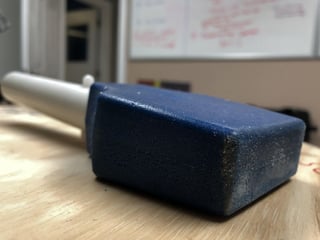
How to Remove Stains from a Fiberglass Pool
Fiberglass Pool Information | Pool Maintenance
In my house, we take turns doing chores, but I’m exclusively in charge of laundry. My favorite (?) part is collecting all the stained clothes so I can apply stain remover and then scrub them like an old-timey washerwoman. It feels as if I should later buy hardened brown sugar in paper bags tied with twine like I live in a Laura Ingalls Wilder book.
But that’s just washing clothes. How do you feel about being an old-timey washer for your inground fiberglass pool stains?
Yes, stains—any type of surface discoloration or blemish. It might be in the pool surface or just on the surface.
Concrete pools have the worst trouble with staining. But it can happen to fiberglass pools too, although we rarely see permanent stains on our pools.
Three things you need to know:
- The types of pool stains
- How to avoid pool stains
- How to remove pool stains
What kind of fiberglass pool stain is it?
All stains can be sorted into two categories: organic or inorganic. Literally everything is one of the two. Sort of like how all people can be categorized as either “pro-cilantro” or “anti-cilantro,” but a more useful dichotomy.
You can use a stain identifying kit—testing agents you add to the water—to know for sure which kind you’re working with.
Side note: We love Jack's Magic, and if (like me) you live for step-by-step instructions, they have a super-helpful identify/remove/prevent program for their products.
Types of organic pool stains
Common sources of organic stains:
- Leaves (green or brown)
- Berries
- Dirt
Algae isn’t a stain, but black algae can look like black spots on the pool surface.
Types of inorganic pool stains
Metal stains
Metal stains used to be common with older, white fiberglass pools, but haven’t been an issue more recently.
They’re pretty easy to deal with. Nice.
Common sources of metal-based stains:
- Iron (orange, brown, or tan)
- Copper (green or blue)
- Manganese (brown, black, or purple)
Cobalt stains
Cobalting shows up as black spots on the surface.
Fun fact: It’s technically not a stain! The water penetrates the gelcoat, reacts with the resin, and creates a black byproduct. It’s caused by osmosis, so it's like osmotic blisters but...not...blisters. Oh.
Calcium scaling
Okay, so this technically isn't staining either, but it rides the same wave.
Scaling is calcium crystals that have built up on top of the pool.
There are two types, calcium carbonate (white, flaky) and calcium silicate (white-grey).
How to tell the difference: drip some muriatic acid on that stuff. Calcium carbonate will react and foam; calcium silicate won't.
How to avoid fiberglass pool stains
As with all problems in a pool (or in life, really), it’s best to prevent stains in the first place rather than clean up the mess later.
These tips apply to all stains, no matter the origin.
Maintain your water chemistry
I know, I know, we say this for everything. That’s because it’s important!
You can prevent all kinds of pool problems by keeping your water levels in the ideal range.
Clean your pool regularly
Scoop out or vacuum dirt, leaves, and bug corpses. This helps keep the waterline from staining.
Bonus: your water will look prettier.
Clear out any foreign metal objects too.
How to remove fiberglass pool stains
Let’s say, theoretically, you have a li’l whoopsie-daisy and a stain shows up in the pool. Have a good cry (I won’t judge), and then we’ll get down to business.
Let’s go basic: see if you can wipe it off. Yes, this is the “have you tried turning it off and on again?” solution of pool cleaning. Yes, you should still do it.
Use a soft sponge/fabric and products that are specific to fiberglass pools. Using harsh chemicals or rough tools could damage the gelcoat.
If the stain remains, your next step depends on the source—the type of stain. Time to use that water testing kit we talked about.
Removing organic stains
Organic stains usually lift out on their own if you brush them.
If hitting it with a brush doesn’t work, rub it with a stain eraser. (This is not, as it turns out, just a Mr. Clean Magic Eraser.)

If a brush and a stain eraser both don’t work, give it time. I know that’s not the magical answer you’re looking for.
At most, the stain should lift out within a couple months. If it doesn’t, call a pro.
Removing nonorganic stains
Metal stains
The simplest route is to rub a vitamin C tablet directly on the stain. This works best with small stains.
The electrolysis causes the metal to release from the surface of the pool.
You’ll then add the appropriate metal sequestering agent to, well, sequester the metal.
For a big stain, you can level up to ascorbic acid:
- Lower the chlorine to 0.0 ppm and the pH to 7.2.
- Run the filter and add ascorbic acid (about one pound per 10,000 gallons) to the water.
- After 24 hours, re-balance the water chemistry.
- Add the sequestering agent to the water.
Calcium scaling
You can remove calcium carbonate using a stain eraser (for quick results) or a fiberglass-pool-safe scaling treatment (added to the water, with slower progress).
Calcium silicate is a tougher row to hoe. You'll need that pool scaling treatment. If you want faster results than that, contact your local pool pros to see if they can help you out.
Want more info about fiberglass pools?
At River Pools, we manufacture world class fiberglass pools for customers across North America. Any questions about fiberglass pools, or even just pools in general? Get in touch with us, and we’ll be happy to help you!
Up Next:
The Ultimate Guide to Inground Pool Maintenance
The Pros and Cons of Fiberglass Pools
What’s the Best Small Fiberglass Pool for Your Needs? Costs, Sizes, Features
Editor's note: This article was originally written by Holly Jender and was updated on September 11, 2024, with current information. River Pools is a brand of inground fiberglass pools produced in a manufacturing facility in Fortville, IN. While our expertise is in manufacturing fiberglass pools, we have access to a network of installers with expertise relating to project design, installation, and pool service. We often tap into this knowledge base and share information freely with homeowners, just like you, considering installing a swimming pool in your backyard.




